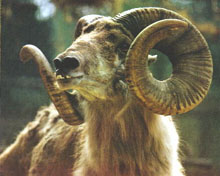An animal researcher said in Urumpi, capital city of Xinjiang Uyger Autonomous Region, Tuesday that they have spotted 2,200 Marco Polo sheep in the part of the Pamirs in northwest China, which indicates that the endangered sub-species of argali sheep is increasing on their homeland.
The discovery showed that the number of Marco Polo sheep, Ovis ammon polii, has increased satisfactorily in China compared with the number in the 1980s, when only about 150 Marco Polo sheep were found in Taxkorgan in the Xinjiang Uygur Autonomous Region, said George B. Schaller of the Wildlife Conservation Society (WCS).
This also proved the effectiveness of the measures China has adopted to protect the endangered species, Schaller said.
Schaller and other researchers from the WCS, the Wildlife Protection Association and Forestry Bureau of the Xinjiang Uygur Autonomous Region, northwest China, began surveying the number of Marco Polo sheep in the part of the Pamirs in Xinjiang last winter and has just concluded the research recently.
The investigation was conducted in an area of 865 square kilometers, with an elevation ranging from 3,700 to 4,700 meters, in the Tajik Autonomous County of Taxhorgan in Kashi Prefecture and the Kirgiz Autonomous Prefecture of Kizilsu in southwestern part of Xinjiang.
Winter is the best season for observing the number of Marco Polo sheep as bucks and ewes mate. Male and female Marco Polo sheep separate from each other, roaming in different places during other seasons of the year, according to animal experts.
 Marco Polo sheep is timid and cautious and often run away when people are one km from them. "It is very hard to count the number of all male and young sheep in a herd," said Schaller.
Marco Polo sheep is timid and cautious and often run away when people are one km from them. "It is very hard to count the number of all male and young sheep in a herd," said Schaller.
Marco Polo sheep mainly roam in the juncture areas on the Pamirs with an elevation of 3,000 to 5,000 meters in the region adjacent to the borders of Afghanistan, Pakistan, Tajikistan and China.
The large-sized sheep has long horns, with the longest one that is so far discovered reaching 1.9 meters and weighing 60 pounds. The pair of eye-catching horns of male sheep often incur disasters to themselves as poachers regard it a top honor to obtain a pair of screwy horns of Marco Polo sheep.
Currently, the number of Marco Polo sheep is no less than 40,000 in the world.
The sheep is named after Italian explorer Marco Polo, who discovered the argali in Xinjiang when he arrived in China traversing the Pamirs in 1273. The explorer's travelogue is known as the first book about China by a Westerner.
But what worries WCS experts is that poaching companies in the United States are making preparations to launch a Marco Polo sheep hunting program to lure tourists. Each tourist will be charged for US$25,000.
Participants in the latest investigation suggested that the four countries, namely China, Tajikistan, Pakistan and Afghanistan should cooperate with each other to protect the Marco Polo sheep and their living environment on the Pamirs.
Currently, Pakistan strictly prohibits poaching Marco Polo sheep and established a 270 sq km protection zone for the endangered animal species. China has also set up a protection zone for the animal in the Tajik Autonomous County of Taxhorgan in Xinjiang.
"We hope an international home for the Marco Polo sheep will be established in the juncture areas between China, Tajikistan, Pakistan and Afghanistan in the near future so that these highland creatures can live in peace on the Pamirs," said Zhu Fude, head of the Wildlife Protection Department of Xinjiang Uygur Autonomous Regional Forestry Bureau.
(Xinhua News Agency April 5, 2006)